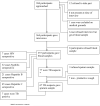Risk factors and prevalence of tuberculosis, human immunodeficiency virus, syphilis, hepatitis B virus, and hepatitis C virus among prisoners in Pakistan
- PMID: 20189863
- PMCID: PMC2905608
- DOI: 10.1016/j.ijid.2009.11.012
Risk factors and prevalence of tuberculosis, human immunodeficiency virus, syphilis, hepatitis B virus, and hepatitis C virus among prisoners in Pakistan
Abstract
Objective: The objective of this study was to evaluate the burden of sexual- and injection drug use-related infections in male prisoners in Karachi, Pakistan.
Methods: We administered a structured questionnaire in a cross-sectional survey of 365 randomly selected imprisoned men. We analyzed blood for the human immunodeficiency virus (HIV), hepatitis B virus (HBV), and hepatitis C virus (HCV) by ELISA, and for syphilis by rapid plasma reagin with Treponema pallidum hemagglutination assay confirmation. Subjects with possible tuberculosis (World Health Organization criteria) provided sputum samples for an acid-fast bacillus smear and culture.
Results: The prevalence of tuberculosis was 2.2% (95% CI 0.71-3.8%). Of 357 of the randomly selected prisoners (eight refused to give blood), 2.0% (95% CI 0.6-3.4) were HIV-infected; syphilis was confirmed in 8.9% (95% CI 6.0-11.8%), HBV in 5.9% (95% CI 3.5-8.3%), and HCV in 15.2% (95% CI 11.7-18.8). By self-report, 59.2% had used any illicit drugs, among whom 11.8% (95% CI 8.5-15.0) had injected drugs. The median length of stay in the prison had been 3.2 (range 1-72) months.
Conclusions: All four infections were prevalent among the prisoners in Pakistan. Prisons are excellent venues for infectious disease screening and intervention given the conditions of poverty and drug addiction. Collaboration with community-based health providers is vital for post-discharge planning.
Keywords: Infectious disease; Pakistan; epidemiology; prison; substance abuse.
Copyright © 2010 International Society for Infectious Diseases. Published by Elsevier Ltd. All rights reserved.
Figures
Similar articles
-
Correlates of HIV, HBV, HCV and syphilis infections among prison inmates and officers in Ghana: A national multicenter study.BMC Infect Dis. 2008 Mar 7;8:33. doi: 10.1186/1471-2334-8-33. BMC Infect Dis. 2008. PMID: 18328097 Free PMC article.
-
Prevalence of human immunodeficiency virus, hepatitis B virus, hepatitis C virus and syphilis among prison inmates and officers at Nsawam and Accra, Ghana.J Med Microbiol. 2006 May;55(Pt 5):593-597. doi: 10.1099/jmm.0.46414-0. J Med Microbiol. 2006. PMID: 16585647
-
Prevalence of tuberculosis, HIV/AIDS, and hepatitis; in a prison of Balochistan: a cross-sectional survey.BMC Public Health. 2019 Dec 4;19(1):1631. doi: 10.1186/s12889-019-8011-7. BMC Public Health. 2019. PMID: 31801496 Free PMC article.
-
Prevalence of HIV, HCV and HBV in Central Asia and the Caucasus: A systematic review.Int J Infect Dis. 2021 Mar;104:510-525. doi: 10.1016/j.ijid.2020.12.068. Epub 2020 Dec 29. Int J Infect Dis. 2021. PMID: 33385583 Free PMC article.
-
Prevention of transmission of HIV, hepatitis B virus, hepatitis C virus, and tuberculosis in prisoners.Lancet. 2016 Sep 10;388(10049):1115-1126. doi: 10.1016/S0140-6736(16)30769-3. Epub 2016 Jul 14. Lancet. 2016. PMID: 27427456 Review.
Cited by
-
HBV prevalence in Sub-continental countries: A systematic review and meta-analysis.PLoS One. 2023 Dec 8;18(12):e0295670. doi: 10.1371/journal.pone.0295670. eCollection 2023. PLoS One. 2023. PMID: 38064471 Free PMC article.
-
Prevalence of tuberculosis and associated risk factors in the Central Prison of Mbuji-Mayi, Democratic Republic of Congo.Trop Med Health. 2016 Sep 20;44:30. doi: 10.1186/s41182-016-0030-9. eCollection 2016. Trop Med Health. 2016. PMID: 27672349 Free PMC article.
-
Pakistan's HIV high-risk populations: Critical appraisal of failure to curtail spread beyond key populations.IJID Reg. 2024 Apr 7;11:100364. doi: 10.1016/j.ijregi.2024.100364. eCollection 2024 Jun. IJID Reg. 2024. PMID: 38660580 Free PMC article. Review.
-
Prisoners co-infected with tuberculosis and HIV: a systematic review.J Int AIDS Soc. 2016 Nov 15;19(1):20960. doi: 10.7448/IAS.19.1.20960. eCollection 2016. J Int AIDS Soc. 2016. PMID: 27852420 Free PMC article.
-
Epidemiology of hepatitis C viral infection in Faisalabad, Pakistan: a retrospective study (2010-2012).Afr Health Sci. 2014 Dec;14(4):810-5. doi: 10.4314/ahs.v14i4.6. Afr Health Sci. 2014. PMID: 25834487 Free PMC article.
References
-
- Bick JA. Infection control in jails and prisons. Clin Infect Dis. 2007 Oct 15;45(8):1047–55. - PubMed
-
- McIntyre AF, Studzinski A, Beidinger HA, Rabins C. STD, HIV/AIDS, and Hepatitis Services in Illinois County Jails. Sex Transm Dis. 2008 Jan 28; - PubMed
-
- Walmsley R. World Prison Population List. [Accessed on 8 January 2009]. 2007. Available at: http://wwwkclacuk/depsta/law/research/icps/downloads/world-prison-pop-se....
-
- UNAIDS 2006 Report on the global AIDS epidemics; A UNAIDS 10th anniversary special edition; Geneva, Switzerland. May 2006; UNAIDS/06.20E.
-
- Niveau G. Prevention of infectious disease transmission in correctional settings: a review. Public Health. 2006 Jan;120(1):33–41. - PubMed
Publication types
MeSH terms
Grants and funding
LinkOut - more resources
Full Text Sources
Medical


